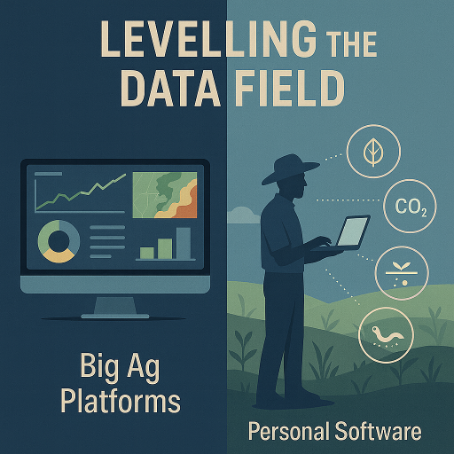Levelling the Data Field: Why AI Could Democratise Farm Insight
- Tim Ashley
- Aug 29
- 2 min read

Until relatively recently, most farm data have been in the hands of big ag platforms, including John Deere, Omnia, Rhiza, and Syngenta’s Cropwise.
They’ve got their place. They make compliance easier, they support R&D, and they’ve brought digital agronomy into the mainstream.
But let’s be honest: they’re built on the conventional “feed the world” narrative. And in practice, that often means:👉 Controlling your data.👉 Keeping you brand loyal.👉 Selling you more inputs.
🚜 The Turning Point
Now we’re at a new moment. The advent of mainstream AI — the kind you can already use today with tools like ChatGPT — changes the rules.
For the first time, you can control your data and how you use it.You can interrogate it in the way that aligns with your farm’s mission and goals.
This is the start of personal software:
Your own analysis.
Your own on-farm trials.
Your own decisions — grounded in your numbers, not somebody else’s brochure.
🔗 Big Platforms vs Personal Software
Big Ag Platforms (Rhiza, Omnia, Cropwise) | Personal Software (AI-driven) |
Centralised, corporate-owned | Farm-owned, farmer-controlled |
Data flows upwards to suppliers/manufacturers | Data stays local — share if you choose |
Optimised for product sales + loyalty | Optimised for your business goals |
Suits conventional input-based systems | Flexible for regenerative systems |
Advice based on generic benchmarks | Insights tailored to your fields, soils, trials |
Agronomy tied to inputs and trials | Agronomy shaped by your objectives and data |
👩🌾 The Rise of a New Agronomist
This shift also creates space for a new kind of advisor:
Proficient in AI, able to help farmers build their own analysis.
Not beholden to ag-chem companies or generic digital platforms.
Not just “independent” but still formulaic, relying on large-scale trials to chase input discounts.
Instead, this new agronomist helps farmers unlock the value of their own data. Supporting on-farm experiments, interpreting biological signals, and aligning decisions with the farm’s objectives — whether that’s profit, carbon, biodiversity, or nutrition.
🌱 Why This Matters
For decades, data has flowed upwards — to manufacturers, to platforms, to suppliers. Now, it can flow back to the farm gate.
That means:
Decisions driven by your business objectives.
Insights shaped around regenerative systems, not just chemical regimes.
Control of your farm returning to where it belongs — you.
✅ Closing Question
A new kind of agronomy is emerging — AI-proficient, farmer-led, and independent.Will AI truly level the data field, or will the balance of power stay with the platforms?





Comments